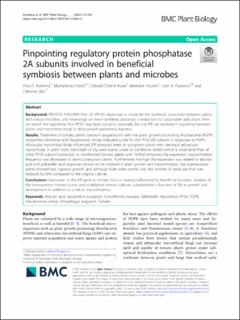| dc.contributor.author | Averkina, Irina Orestovna | |
| dc.contributor.author | Harris, Muhammad | |
| dc.contributor.author | Asare, Edward Ohene | |
| dc.contributor.author | Hourdin, Bérénice | |
| dc.contributor.author | Paponov, Ivan | |
| dc.contributor.author | Lillo, Cathrine | |
| dc.date.accessioned | 2021-08-24T14:14:55Z | |
| dc.date.available | 2021-08-24T14:14:55Z | |
| dc.date.created | 2021-06-29T09:31:16Z | |
| dc.date.issued | 2021-04 | |
| dc.identifier.citation | Averkina, I. O., Harris, M., Asare, E.O. et al. (2021). Pinpointing regulatory protein phosphatase 2A subunits involved in beneficial symbiosis between plants and microbes, 21:183 | en_US |
| dc.identifier.issn | 1471-2229 | |
| dc.identifier.uri | https://hdl.handle.net/11250/2771038 | |
| dc.description.abstract | Background
PROTEIN PHOSPHATASE 2A (PP2A) expression is crucial for the symbiotic association between plants and various microbes, and knowledge on these symbiotic processes is important for sustainable agriculture. Here we tested the hypothesis that PP2A regulatory subunits, especially B’φ and B’θ, are involved in signalling between plants and mycorrhizal fungi or plant-growth promoting bacteria.
Results
Treatment of tomato plants (Solanum lycopersicum) with the plant growth-promoting rhizobacteria (PGPR) Azospirillum brasilense and Pseudomonas simiae indicated a role for the PP2A B’θ subunit in responses to PGPR. Arbuscular mycorrhizal fungi influenced B’θ transcript levels in soil-grown plants with canonical arbuscular mycorrhizae. In plant roots, transcripts of B’φ were scarce under all conditions tested and at a lower level than all other PP2A subunit transcripts. In transformed tomato plants with 10-fold enhanced B’φ expression, mycorrhization frequency was decreased in vermiculite-grown plants. Furthermore, the high B’φ expression was related to abscisic acid and gibberellic acid responses known to be involved in plant growth and mycorrhization. B’φ overexpressor plants showed less vigorous growth, and although fruits were normal size, the number of seeds per fruit was reduced by 60% compared to the original cultivar.
Conclusions
Expression of the B’θ gene in tomato roots is strongly influenced by beneficial microbes. Analysis of B’φ overexpressor tomato plants and established tomato cultivars substantiated a function of B’φ in growth and development in addition to a role in mycorrhization. | en_US |
| dc.language.iso | eng | en_US |
| dc.publisher | BioMed Central | en_US |
| dc.rights | Navngivelse 4.0 Internasjonal | * |
| dc.rights.uri | http://creativecommons.org/licenses/by/4.0/deed.no | * |
| dc.subject | Azospirillum brasilense | en_US |
| dc.subject | Funneliformis mosseae | en_US |
| dc.subject | PP2A | en_US |
| dc.subject | mycorrhiza | en_US |
| dc.subject | Pseudomonas simiae | en_US |
| dc.subject | tomater | en_US |
| dc.title | Pinpointing regulatory protein phosphatase 2A subunits involved in beneficial symbiosis between plants and microbes | en_US |
| dc.type | Peer reviewed | en_US |
| dc.type | Journal article | en_US |
| dc.description.version | publishedVersion | en_US |
| dc.rights.holder | © The Author(s). 2021 | en_US |
| dc.subject.nsi | VDP::Matematikk og Naturvitenskap: 400::Basale biofag: 470 | en_US |
| dc.subject.nsi | VDP::Matematikk og Naturvitenskap: 400::Zoologiske og botaniske fag: 480 | en_US |
| dc.source.volume | 21 | en_US |
| dc.source.journal | BMC Plant Biology | en_US |
| dc.identifier.doi | 10.1186/s12870-021-02960-4 | |
| dc.identifier.cristin | 1919170 | |
| dc.relation.project | Norges forskningsråd: 255613 | en_US |
| dc.source.articlenumber | 183(2021) | en_US |
| cristin.ispublished | true | |
| cristin.fulltext | original | |
| cristin.qualitycode | 2 | |

